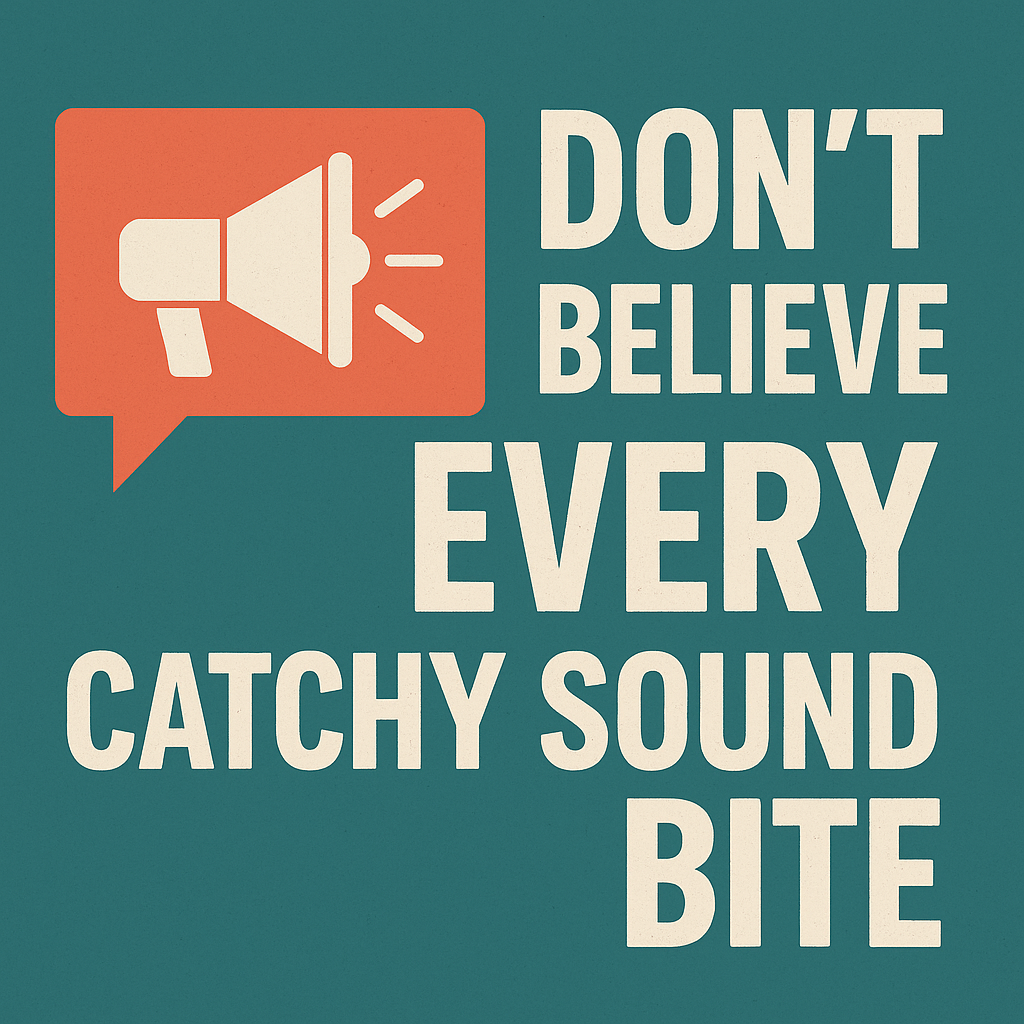Introduction: The Age of Shiny Statements
We live in an era where flashy declarations spread faster than nuanced truths. A single catchy sound bite—“Email is dead,” “AI will take all our jobs,” “Text-based SOPs are dying”—can ricochet through LinkedIn feeds, TikTok shorts, and conference stages, shaping opinion in a way that feels authoritative but rarely is.
The problem isn’t that these claims are always wrong. The problem is that they’re almost never the full picture. They’re designed to spark engagement, not to educate. They flatten complex subjects into neat, tweetable lines that get attention but leave out the critical nuance.
And in business, education, and technology, nuance is everything.
Why We Fall for Sound Bites
Before tearing into the dangers, it’s worth acknowledging why catchy claims are so seductive:
- Cognitive ease Our brains like shortcuts. A polished phrase is easier to remember than a balanced explanation. “Video killed the text SOP” sounds sharper than “People have diverse learning preferences, and different formats work better for different tasks.”
- Authority bias If a confident speaker at a conference says it, or if an influencer repeats it, we subconsciously assign weight to their words, even if they’re unsupported.
- Fear of missing out In fast-moving industries, nobody wants to look outdated. If “the future is video” becomes the mantra, managers and entrepreneurs feel pressured to adopt it—or risk being labelled old-fashioned.
- The dopamine hit Social platforms reward engagement. Posts with big, bold claims rack up likes, shares, and comments, creating a feedback loop that pushes influencers toward more extreme, absolute statements.
Case Study: “Text-Based SOPs Are Dying”
This is a perfect example of how a claim can sound reasonable while being wrong.
On the surface, it makes sense: video is popular, people scroll TikTok for hours, YouTube is the second-largest search engine in the world. Surely that means learning has shifted too, right?
Not quite. Research on learning styles and retention consistently shows that people don’t magically become “visual learners” just because video exists. Some learn best by reading and writing. Some retain more through hands-on practice. Some prefer auditory learning.
What video has done is become more accessible and easier to produce. That doesn’t mean text instructions are obsolete—it means we now have more tools in the kit. The best standard operating procedures (SOPs) combine text, images, and sometimes video. Each has its strengths:
- Text is precise, searchable, fast to update.
- Images clarify context.
- Video shows motion or tone.
Declaring that text SOPs are “dying” is both inaccurate and harmful. It pressures teams to abandon proven methods for the sake of chasing what sounds modern.
The Real Dangers of Sound Bites
1. Bad Decisions Based on Bad Assumptions
If a leader believes “text SOPs are dead,” they may sink resources into building a video library instead of maintaining written documentation. When a process changes, updating 50 videos is far more costly than updating 50 lines of text. That’s not innovation—that’s waste.
2. Loss of Accessibility
Not everyone can consume video easily. Low bandwidth environments, disabilities, or even just personal preference mean text remains critical. Sound-bite thinking ignores these groups, reducing inclusivity.
3. The Cult of the New
Flashy claims often push businesses toward novelty over utility. It’s not about what works—it’s about what sounds cutting-edge. That’s how companies burn money chasing trends instead of building durable systems.
4. Fragile Knowledge Systems
Text documentation endures. It can be archived, searched, indexed, and backed up. Video? It’s larger, harder to parse, and far more brittle. A flashy shift to “all video” risks knowledge loss down the road.
5. Credibility Loss
When people discover that the bold claim was hollow, trust erodes. Once burned, your audience, employees, or customers may become skeptical of future guidance—even when it’s solid.
A Better Approach: Pause, Question, Verify
So how do we defend against the seduction of sound bites?
- Pause before you share Does the claim feel too neat? Too extreme? That’s a red flag.
- Ask for evidence Is there actual research behind the statement, or is it opinion dressed up as fact? “Show me the data” is a good default.
- Check for nuance Reality is rarely binary. If a statement offers only one future—“text is dead, video is the only way”—you’re probably dealing with marketing, not science.
- Consider the context Who benefits if people believe this claim? Is it someone selling video production services, an AI product, or a shiny new platform? Always follow the incentives.
- Look for complementarity Instead of “X killed Y,” ask: How do X and Y work together? That question almost always reveals the practical truth.
Why This Matters in the AI Era
We’re seeing the same problem play out in artificial intelligence. “AI will replace humans.” “Prompt engineering is dead.” “Coding is obsolete.” These claims go viral because they’re simple and dramatic. But they ignore the messy, transitional, hybrid reality of how AI is actually being integrated.
Business leaders who chase the sound bites without digging deeper risk wasting resources, confusing their teams, and falling behind competitors who take a more measured approach.
The winners in this space will be the ones who slow down, verify the claims, and build systems that balance hype with practicality.
Conclusion: Keep Your Skeptic Hat On
Sound bites aren’t going away. They’re too effective at getting attention. But attention is not the same as truth, and it’s certainly not the same as wisdom.
When you hear a claim like “text SOPs are dying,” treat it the same way you’d treat a “miracle cure” headline: with skepticism. Pause. Ask for evidence. Review the science.
Sometimes the claim will contain a kernel of truth. But more often, you’ll discover the world is more complex than the slogan suggests. And that complexity—the messy middle—is where the real opportunities lie.
TL;DR: Flashy sound bites spread fast but often distort reality. Before acting on bold claims like “text SOPs are dead,” pause and check the science. The future isn’t about one medium replacing another—it’s about balancing multiple tools for diverse needs.
And as always …
StayFrosty!
Q&A Summary:
Q: Why are sound bites often misleading?
A: Sound bites are often misleading because they rarely present the full picture. They're designed to spark engagement, not to educate. They flatten complex subjects into neat, tweetable lines that get attention but leave out the critical nuance.
Q: Why do people tend to believe sound bites?
A: People tend to believe sound bites due to cognitive ease, authority bias, fear of missing out, and the dopamine hit from social platforms rewarding engagement.
Q: Is the claim that 'text-based SOPs are dying' accurate?
A: No, the claim that 'text-based SOPs are dying' is not accurate. While video has become more accessible and easier to produce, it doesn't mean text instructions are obsolete. People have different learning styles and preferences, and the best SOPs often combine text, images, and sometimes video.
Q: What are the dangers of believing in sound bites?
A: The dangers of believing in sound bites include making bad decisions based on bad assumptions, loss of accessibility, falling into the cult of the new, creating fragile knowledge systems, and suffering credibility loss.
Q: What is a better approach to handle sound bites?
A: A better approach to handle sound bites is to pause before sharing, ask for evidence, check for nuance, consider the context, and look for complementarity.


